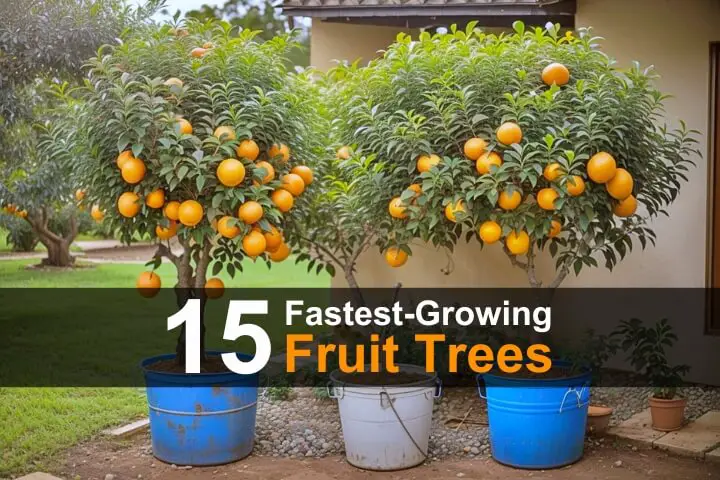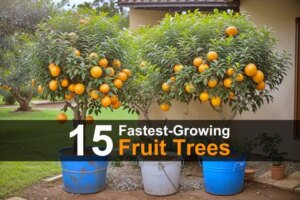15 Quickest-Rising Fruit Bushes

Estimated studying time: 13 minutes
Fruit bushes are nice, however everybody is aware of they take without end to supply. It’s true that you simply received’t get a fruit harvest the primary 12 months you plant a tree, however when you decide one of many fastest-growing fruit bushes in your yard, you may get to eat fruit sooner.
Except for planting the best bushes, one other solution to get fruit earlier is by planting a grafted tree that you simply buy from a nursery reasonably than beginning bushes from seeds. If you happen to begin a fruit tree from a seed, it takes for much longer to obtain a harvest, and a few folks argue that rising from seed will produce fruit that doesn’t style like the unique model.
As a substitute of ready a decade to reap fruit out of your bushes, attempt planting a number of of those fastest-growing fruit bushes.
Wish to save this submit for later? Click on Right here to Pin It On Pinterest!
Apple Tree

To develop apple bushes, you should be in an space that has some chilly climate, which is named chill hours. Additionally, apple bushes want one other tree to cross-pollinate to supply fruit. In any other case, you may have beautiful bushes with none apples.
If you happen to dwell in a area that has a milder local weather, make certain to have a look for tree varieties that require low chill hours.
Apricot Tree

Not all apricot bushes develop as rapidly as different ones. Two apricot varieties, specifically, develop quick – the “Moorpark” and the “Early Golden.” Each of those varieties develop effectively in USDA zones 5 to eight, producing white or pink blossoms that flip into scrumptious, flavorful fruit.
Banana Vegetation

Technically, bananas aren’t bushes—they’re big herbs—however they produce fruit so rapidly that they deserve a spot on this record. If you happen to dwell in a heat local weather (USDA zones 9/11), banana vegetation can develop as much as 10 toes in a single 12 months and begin producing bananas inside 9 to 12 months.
Even when you don’t dwell in a tropical area, you possibly can develop dwarf banana varieties in containers and produce them indoors in the course of the winter. Simply make certain they get loads of daylight and common watering. Here is a information on the right way to develop your individual bananas.
Cherry Bushes

You can provide planting cherry bushes a attempt as effectively. Some varieties, comparable to black cherries, develop three toes every season, ultimately reaching 50 toes in peak. Black cherries develop in USDA zones 3 to 9. You’ll love their present of white flowers within the spring, and by the summer season, the bushes are filled with cherries.
Citrus Bushes

Rising citrus bushes is extremely dependent in your local weather and the place you reside. Usually, lemon and orange bushes have to be planted in USDA zones 9 and better as a result of they’re incapable of dealing with frosts. So, which means most individuals are unable to develop citrus fruits exterior.
You’ll be able to develop citrus bushes indoors, comparable to Meyer lemons and Satsuma oranges. The very best varieties for containers are dwarf bushes, and also you deliver them inside after they go dormant.
In contrast to peach bushes, citrus fruit bushes are self-pollinating, so that you solely want one tree to supply the fruit. Usually, they begin producing fruit the 12 months after they’re planted however are absolutely producing by three years.
Fig Bushes

Sooner or later, I got here residence, and my husband planted a fig tree in our entrance backyard. Surprisingly, fig bushes produce rapidly and are simple to develop. These bushes favor heat climate, so you should plant them in a container and produce them inside when chilly climate strikes.
You solely must have one fig tree to supply, and it solely takes two years to get fruit. Figs are self-fertile, so that you don’t want to attend for them to flower. They only produce fruit.
When left within the floor reasonably than introduced indoors and open air with a container, fig bushes can attain as much as 30 toes tall inside 5 years. That doesn’t imply you should wait till you might have a big tree. Our small three-foot fig tree produces lots every year.
Figs are rising in recognition, so yow will discover many various kinds of figs out there. You’ll be able to simply discover one that’s well-adapted to your local weather zone.
Guava Bushes

In order for you a fast-growing tropical fruit, guava bushes are a incredible alternative. Guava bushes develop in USDA zones 9/11, and in the best circumstances, they’ll develop as much as 4 toes per 12 months.
The very best half? Guava bushes begin producing fruit in as little as two years! They thrive in heat climates however will also be grown in containers and introduced indoors when temperatures drop.
Jujube Bushes

The jujube tree, additionally known as the Chinese language date, is among the fastest-growing and most drought-tolerant fruit bushes. These bushes develop over a foot per 12 months and begin producing fruit inside 2-3 years.
Jujube bushes develop in USDA zones 6-10, require minimal upkeep, and may deal with each warmth and chilly. The fruit is good, chewy, and filled with vitamins!
Mandarins

Mandarins are one other citrus kind fruit, but it surely’s a lot simpler to develop than conventional oranges or lemons. Children love mandarins; they’re a well-liked snack, and yow will discover a number of dwarf varieties for various climates. You have to to develop them in containers to deliver the bushes out and in of your private home or heated greenhouse.
You’ll be able to develop mandarin bushes from seed fairly simply, however it’ll take seven years to supply a harvest. Grafted bushes create a yield two to 3 years after planting.
Wherever you plan to develop your mandarin tree, ensure that it receives 5-6 hours of daylight every day, and also you present it with barely acidic soil. One thing that you will like is that these vegetation do not require pruning to supply so that you could take that off of your to-do record.
Mulberry Bushes

Mulberry bushes produce after one 12 months when you begin with a grafted tree. You’ll be amazed by how briskly these bushes can develop, sometimes 2.5 toes per 12 months. The one drawback with mulberries is that volunteer bushes are likely to pop up throughout your property.
Mulberry bushes can produce for many years. A 3-year-old tree can attain 12 toes tall, at a minimal. That’s spectacular! Additionally, mulberry bushes are heavy producers, so you possibly can count on them to supply plentiful harvests as soon as the bushes are well-established.
Papaya Bushes

For these in tropical or subtropical climates, the papaya tree is a fast-growing possibility that may begin producing fruit throughout the first 12 months of planting, particularly when you begin with a younger tree reasonably than seeds. Papaya bushes love the warmth and have to be shielded from the wind. They require ample daylight and common watering however are comparatively low-maintenance as soon as established.
These bushes are self-fertile, and many sorts are dwarf, making them appropriate for smaller areas and even container gardening. The papaya’s speedy progress and early fruiting make it an thrilling alternative for gardeners desirous to get pleasure from homegrown tropical fruits and not using a lengthy wait.
Peach Bushes

Peach bushes are enjoyable to develop and are one of many quickest selections, and whereas peaches and nectarines aren’t the identical fruit, they do have related rising wants. So, if you find yourself rising and loving peaches, give nectarines a attempt.
Peach bushes dislike soggy roots, so you should ensure that you plant them in an space that has good drainage. Additionally, you may must plant two peach bushes to supply fruit, however some varieties are self-fertile. Be sure to decide two various kinds of bushes that can bloom on the similar time. They should cross-pollinate.
Most peach tree takes three years to fruit, but it surely’s depending on how effectively you maintain the bushes.
Pear Tree

One other fast-growing fruit tree in your yard is a pear tree. Relying on the variability that you choose, they are often present in USDA zones 4-9. These bushes can develop as much as 20 toes excessive, producing beautiful white blossoms earlier than turning to fruit.
Some varieties are prepared to reap within the later summer season months, however some will not ripen till the early fall.
Plum Bushes

Plum bushes usually are not solely admired for his or her lovely spring blossoms but additionally for his or her speedy progress fee and early fruit manufacturing. With varieties appropriate for a variety of climates, plums is usually a welcome boost to any backyard. These bushes sometimes begin bearing fruit inside just some years after planting.
Plum bushes require well-drained soil and full solar publicity to thrive. Whereas some varieties are self-pollinating, planting two completely different varieties can guarantee a extra dependable and plentiful harvest. Whether or not you select European plums for his or her candy, deep flavors or Japanese plums for his or her juicier and bigger fruits, you are in for a deal with with fast-growing plum bushes.
Pomegranate Bushes

Pomegranate bushes are recognized for his or her resilience, drought tolerance, and comparatively quick progress, making them a superb alternative for gardeners seeking to get pleasure from fruit rapidly. Whereas they’ll take a number of years to begin producing fruit, with correct care, you may see your first harvest as quickly because the second or third 12 months after planting.
These bushes favor sizzling summers and funky winters, thriving in USDA zones 7-10. Pomegranates are self-fertile, so that you solely want one tree to supply fruit. The tree’s gorgeous orange-red flowers add magnificence to any backyard, and its fruit is filled with well being advantages, making it a doubly rewarding alternative.
Ideas for Rising Dwarf Fruit Bushes
Normally, rising dwarf fruit bushes is a part of the answer in order for you fast-growing bushes. These bushes attain a peak of 10 toes or much less, typically, however some may be as small as three toes at full maturity. Regardless of their smaller dimension, their fruit is normal-sized, so that you aren’t ripped off getting tiny apples.
Listed below are some suggestions and ideas when rising dwarf fruit bushes.
All the time Take a look at Chill Hours
Some fruit bushes want a particular variety of days when the temperatures are at or beneath 45℉ each winter into spring. This era ends their dormancy, encouraging the tree to flower and begin the method of bearing fruit.
If you happen to dwell someplace heat, comparable to Texas, you may want a attempt with low-chill hours required.
Know Their Warmth Tolerance
What kind of climate does the tree favor? Apples want cool nights and heat days. Peaches favor lengthy, sizzling summers, however cherries favor a cooler local weather. You must make certain the fruit tree you choose can deal with the common summer season warmth in your space.
Look At Pollination Wants
Some bushes must have a second tree close by for cross-pollination. You don’t at all times must have two of the identical varieties, however you do must buy two bushes without delay. Different bushes self-pollinate!
Decide The Proper Container Measurement
You CAN develop dwarf fruit bushes in containers, however you should be sure you have the best container dimension. Search for a 15-20 gallon container with holes for drainage on the backside of the pot. Think about including rocks on the backside of the container to assist with drainage.
Dig A Deep Sufficient Gap
Digging a gap that’s deep sufficient in your tree is crucial. The outlet must be 12-18 inches deep and extensive, at minimal. Additionally, just be sure you decide an space that will get 6-8 hours of daylight per day.
Once you put the tree into the outlet, make certain the grafted joint stays two inches above the soil. The joint must be seen on the base of the tree.
Don’t Overwater
Bushes want and love water, however dwarf fruit bushes don’t want or wish to be overwatered. This tip is particularly true when you’re rising your tree in a container. Watering a couple of times per week is ample. If you happen to encounter a sizzling, dry week in the summertime, you may want so as to add a 3rd watering, however that shouldn’t be the entire time.
Make Positive to Feed Your Tree
Feeding your tree is a vital step to not overlook. Add compost round your tree a couple of times a 12 months. Attempt watering it with compost tea and utilizing dietary supplements for the soil. Feeding your tree is especially essential when you’re rising bushes in containers.
Who needs to attend for years and years to eat recent apples from their tree? Not you! Whilst you may add some conventional fruit bushes to your property, you can also and will add a few of the fastest-growing fruit bushes. That approach, you possibly can have a fruit harvest by the second or third 12 months after planting!
Like this submit? Do not Overlook to Pin It On Pinterest!
You Might Additionally Like:










